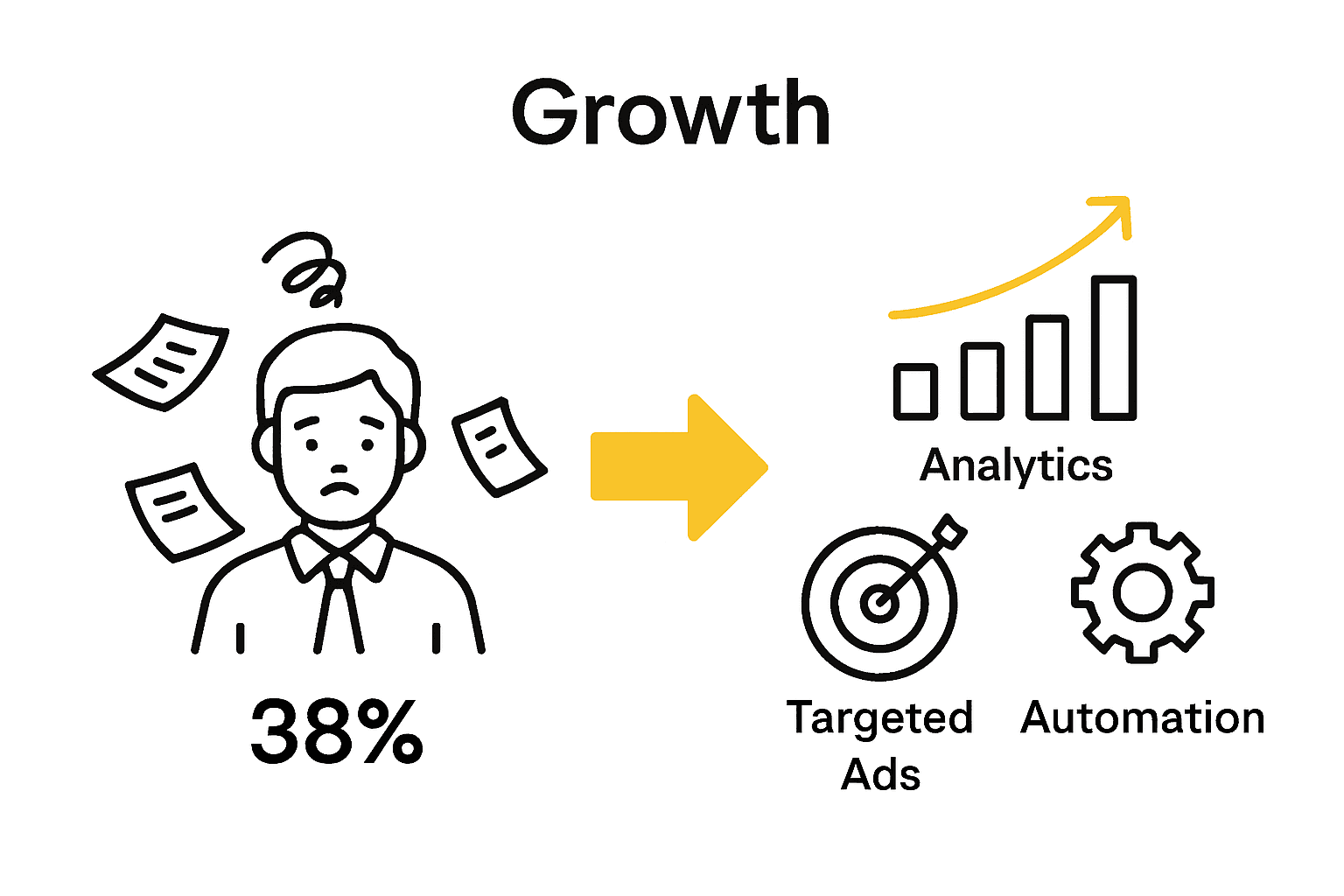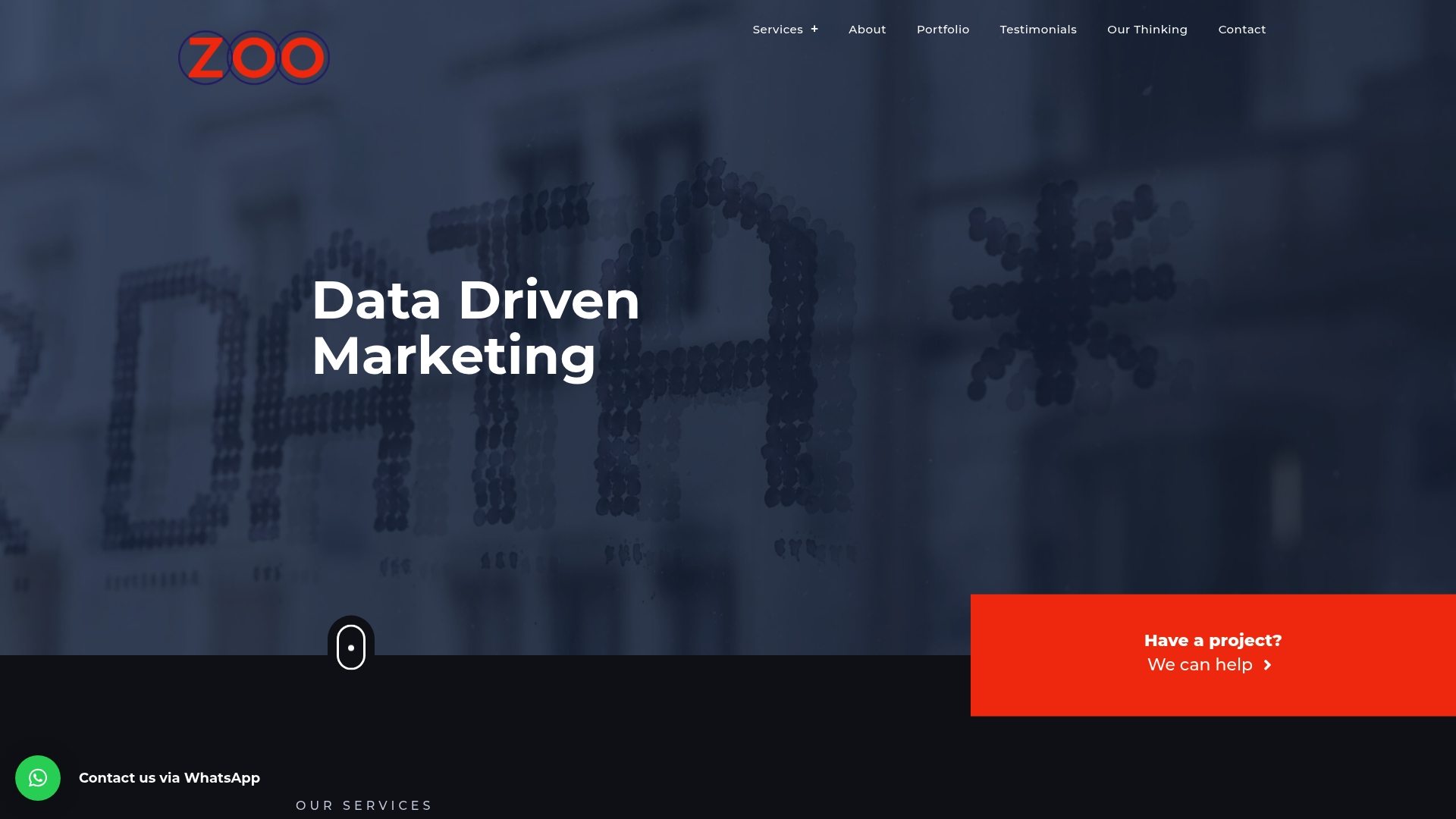Did you know that only 38 percent of small businesses use digital marketing tools effectively? Many owners feel overwhelmed by jargon, technology gaps, or limited skills. Yet a strong digital presence opens doors to more customers, better insights, and stronger sales.
 Whether you are just starting or ready to take your strategy further, simple adjustments can set you on a path to real growth in today’s market.
Whether you are just starting or ready to take your strategy further, simple adjustments can set you on a path to real growth in today’s market.
Quick Summary
| Key Point | Explanation |
|---|---|
| 1. Assess digital marketing readiness | Evaluate your team’s skills and resources to identify gaps and opportunities for improvement in digital marketing. |
| 2. Implement robust analytics tools | Use platforms like Google Analytics to track essential metrics and gain insights into your audience’s behavior and engagement. |
| 3. Launch targeted advertising campaigns | Develop strategic ad campaigns focused on specific audience segments to maximize engagement and conversion rates. |
| 4. Optimize CRM and automation processes | Automate repetitive tasks and personalize communication to enhance customer relationships and save time. |
| 5. Review results and refine strategies | Analyze your marketing performance regularly to make data-driven adjustments and improve effectiveness continually. |
Table of Contents
- Step 1: Assess Digital Marketing Readiness
- Step 2: Implement Essential Tracking And Analytics
- Step 3: Launch Targeted Advertising Campaigns
- Step 4: Optimize CRM And Automation Processes
- Step 5: Review Results And Refine Strategies
Step 1: Assess digital marketing readiness
This section will help you understand where your small business stands in digital marketing preparedness and give you a clear roadmap for improvement. Digital marketing readiness isn’t about having fancy tools it’s about strategic alignment and capability.
Start by taking an honest inventory of your current digital capabilities. According to a 2025 peer-reviewed study, internal factors like knowledge, experience, and functional capabilities significantly influence digital marketing success. Ask yourself key questions: What digital skills do my team members possess? What online marketing channels are we currently using? What are our digital knowledge gaps?
Take a systematic approach to this assessment. Create a simple spreadsheet tracking your current digital assets digital skills present in your team technological infrastructure and existing online marketing efforts. Look at your website performance social media engagement email marketing capabilities and overall online presence.
Pro Tip: Be brutally honest during this self-assessment. Recognizing limitations is the first step toward meaningful improvement.
Interestingly a recent empirical study on micro-businesses revealed that only 38% of small businesses effectively engage with digital marketing tools. Common barriers include low digital literacy perceived high costs and infrastructure limitations. Understanding these potential roadblocks helps you strategically plan your digital transformation.
Here’s a summary of common digital marketing readiness factors for small businesses:
| Factor | Typical Barriers | Recommended Actions |
|---|---|---|
| Team digital skills | Low digital literacy | Upskill staff Hire specialists |
| Online marketing channels | Limited platforms | Expand presence Test new channels |
| Technological infrastructure | Outdated or inadequate tech | Upgrade tools Seek affordable options |
| Digital knowledge gaps | Lack of training | Attend workshops Consult experts |
| Engagement with digital tools | Under-utilised resources | Internal audits Adopt best practices |
If you discover significant skill gaps consider targeted training programs or workshops. Some businesses find it beneficial to hire a digital marketing consultant who can provide an external perspective on your readiness and recommend specific improvements.
By the end of this assessment you will have a clear snapshot of your digital marketing landscape ready to move forward with targeted strategy development.
 The next step involves translating these insights into a actionable digital marketing plan tailored specifically to your business needs.
The next step involves translating these insights into a actionable digital marketing plan tailored specifically to your business needs.
Step 2: Implement essential tracking and analytics
Tracking and analytics transform raw website data into meaningful insights that drive your digital marketing strategy. In this step youll learn how to set up powerful analytics tools that help you understand your audience and measure your online performance.
Start by selecting an analytics platform that matches your business needs. Our guide on marketing analytics for small businesses can help you navigate this process. According to recent research on web analytics, privacy-friendly tools like Plausible Analytics offer an excellent solution for small businesses. This open-source tool provides visitor insights while maintaining GDPR and CCPA compliance without using invasive cookies.
Implement tracking across multiple digital channels. This means setting up Google Analytics on your website connecting social media tracking pixels and ensuring you can monitor key performance indicators like website traffic conversion rates and user engagement. The CAWAL framework presents an advanced approach to web analytics that enables precise tracking with integrated application logging.
Pro Tip: Always prioritize data privacy and be transparent with your website visitors about what information you are collecting.
Focus on metrics that genuinely matter to your business. Dont get lost in vanity numbers like total page views. Instead track meaningful data such as conversion rates time spent on page bounce rates and source of traffic. These insights will help you understand what content resonates with your audience and where you need to improve.
Consider setting up conversion tracking for specific business goals. Want to measure how many website visitors become leads? Track form submissions. Selling products online? Monitor purchase completions. Each conversion tells a story about your marketing effectiveness.
By implementing robust tracking and analytics youre setting the foundation for data-driven decision making.
The next step is learning how to interpret these insights and translate them into actionable marketing strategies that grow your business.
Step 3: Launch targeted advertising campaigns
Targeted advertising transforms how small businesses connect with potential customers turning limited marketing budgets into powerful growth engines. In this step youll learn how to create strategic ad campaigns that reach the right people at the right time.
How to start online advertising begins with understanding your audience deeply. According to 2025 marketing research small businesses are shifting towards behavior-based segmentation creating tight audience profiles that maximize engagement. This means moving beyond basic demographics and exploring how your potential customers actually behave online.
Choose your advertising platforms strategically. Google Ads Meta Ads and LinkedIn offer robust targeting options that let you narrow down audiences based on interests behaviors and specific characteristics. Interesting developments like Taboola’s generative AI assistant ‘Abby’ are making ad creation more accessible by helping businesses generate compelling ad copy and visuals through conversational prompts.
Pro Tip: Start with a small budget and test multiple ad variations to see what resonates with your audience before scaling up.
Focus on creating engaging ad formats. Recent trends show small businesses are moving towards video-first creative approaches and interactive ad formats that capture attention quickly. Your ads should tell a story solve a problem or provide clear value to your potential customers.
Implement retargeting strategies using your CRM database. This means showing ads to people who have already interacted with your business creating a more personalized advertising experience. By focusing on people who have demonstrated previous interest you increase the likelihood of conversion while managing your advertising spend more efficiently.
Always track your campaign performance and be prepared to adjust. The most successful advertising strategies are those that remain flexible and responsive to real-world results. Your next step involves analyzing these initial campaigns and refining your approach based on actual performance data.
Step 4: Optimize CRM and automation processes
CRM and marketing automation transform how small businesses manage customer relationships and streamline repetitive marketing tasks. In this step youll learn how to select and implement powerful automation tools that save time and improve customer engagement.
Explore our guide on marketing automation to get started. Platforms like Act-On offer comprehensive solutions that integrate multiple marketing functions. This means you can manage email marketing landing pages social media prospecting lead scoring and analytics all from a single platform.
Begin by mapping out your current customer journey. Where are the bottlenecks in your current process? Which tasks consume most of your teams time? Look for repetitive activities like lead follow-up email sequences customer segmentation and reporting that could be automated.
Pro Tip: Choose a CRM that integrates smoothly with your existing tools to prevent data silos and streamline your workflow.
Focus on personalizing your automation. Generic automated messages feel impersonal and can damage customer relationships. Configure your CRM to use dynamic content that adapts based on customer behavior interests and previous interactions. This means creating targeted email sequences segmented communication and personalized follow-up processes.
Set up lead scoring mechanisms to prioritize your most promising prospects. This helps your sales team focus energy on contacts most likely to convert. Implement triggers that automatically notify your team when a lead reaches a certain engagement threshold or demonstrates high purchase intent.
Regularly audit and refine your automation processes. Technology evolves quickly and what works today might become less effective tomorrow. Plan to review your CRM and automation setup quarterly to ensure youre using the most efficient workflows and taking advantage of new features.
By optimizing your CRM and automation you create a powerful system that works continuously in the background growing your business. Your next step involves integrating these tools with your broader digital marketing strategy to create a seamless customer experience.
Step 5: Review results and refine strategies
Digital marketing is an ongoing journey of learning and adaptation. In this final step youll discover how to analyze your results transform insights into actionable improvements and continuously evolve your marketing approach.
Master analyzing website performance provides critical context for this process. According to a systematic literature review covering SME digital marketing trends from 2018 to 2024 internet penetration adaptability and digital innovation drive successful marketing outcomes. This means your review process should be dynamic and forward thinking.
Start by gathering comprehensive performance data from all your digital marketing channels. Look beyond surface level metrics and dig deep into what the numbers truly represent. Compare your current performance against your initial goals. Which strategies delivered the best results? Where did you fall short? Analyze conversion rates engagement levels customer acquisition costs and return on investment for each marketing initiative.
Pro Tip: Create a monthly dashboard that tracks key performance indicators to maintain consistent visibility into your marketing effectiveness.
A 2022 analytical study highlighted that digital marketing strategies like online advertising social media and SEO directly enhance business performance. Use this insight to prioritize refinement efforts. If certain channels consistently underperform consider reallocating resources to more effective platforms.
Embrace a culture of continuous experimentation. Small strategic adjustments can yield significant improvements. Test different messaging variations audience targeting and content formats. Document your experiments and their outcomes to build an internal knowledge base that guides future marketing decisions.
Remember that digital marketing is not about perfection but progression. Be prepared to pivot quickly when data suggests a change in strategy. Your willingness to learn adapt and innovate will ultimately determine your marketing success.
With these refined strategies in place youre now equipped to drive sustainable growth through intelligent digital marketing. Keep learning stay curious and never stop improving your approach.
Ready to Take Your Small Business Digital Marketing Further?
Struggling to turn honest self-assessment into real progress? If you relate to challenges like digital skills gaps, limited analytics, and underperforming advertising, you’re not alone. Many small businesses feel stuck despite following guides like our Top Tips for Small Business Growth with Digital Marketing. Your goals deserve more than theory. They need real action backed by expert support.

Let us help you bridge those gaps. At Zoo Digital, we make digital marketing practical and powerful for small businesses. From hands-on tracking setup to targeted Google and Meta Ads, dynamic Hubspot CRM management, and automation, our team is here to fast-track your progress. You can explore more solutions and inspiration in our Uncategorized Archives or start today at our main site. Your growth can’t wait. Reach out now to turn potential into genuine results.
Frequently Asked Questions
How can I assess my small business’s digital marketing readiness?
To assess your digital marketing readiness, take an inventory of your current digital capabilities, including your team’s skills, online marketing channels, and technological infrastructure. Create a spreadsheet to track your digital assets and analyze your online presence. Conduct this assessment within two weeks to identify immediate areas for improvement.
What key metrics should I track to measure online performance?
Focus on metrics that matter for your business, such as conversion rates, time spent on page, and bounce rates. Avoid vanity metrics like total page views. Start by setting up a monthly reporting system to gather these insights regularly.
How do I launch targeted advertising campaigns for my small business?
Begin by understanding your audience through behavior-based segmentation, then choose appropriate advertising platforms like Google Ads or Meta Ads. Create engaging ads that tell a story and test multiple variations with a small budget over the first month to find what resonates best.
What steps should I take to optimize my CRM and automation tools?
To optimize your CRM and automation tools, first map out your customer journey to identify bottlenecks and repetitive tasks. Then select a CRM that integrates well with your existing tools and set up automation for personalizing communication. Conduct this process over 30 days to refine your customer engagement strategies.
How can I review my digital marketing results and refine my strategies?
Collect comprehensive performance data from your digital marketing efforts and compare it against your initial goals. Regularly analyze key performance indicators and be open to making small adjustments based on the data. Aim for a quarterly review cycle to ensure continuous improvement in your marketing approach.
Recommended
- Digital Marketing for Beginners: 2025 Guide for Small Businesses – Zoo Digital
- How to Build a Marketing Strategy for Small Businesses in 2025 – Zoo Digital
- Digital Marketing Terms Explained for Small Businesses 2025 – Zoo Digital
- How to Start Online Advertising: Guide for Small Businesses 2025 – Zoo Digital

